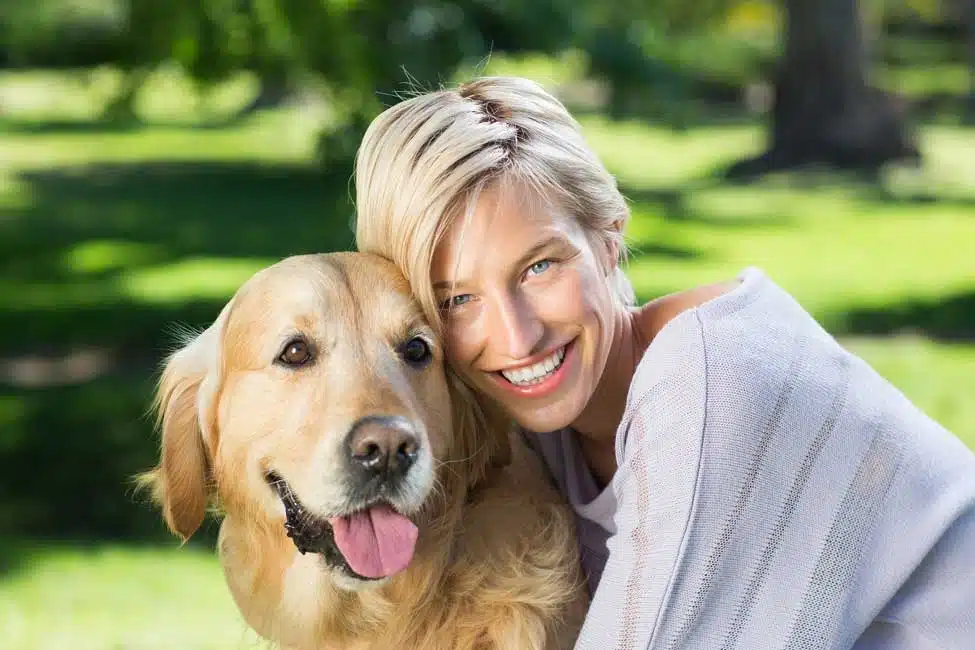
For dog-loving pet owners, few things are more devastating than an allergy to their pet. After all, when a runny nose, constant sneezing, itchy skin, hives, and watery eyes dominate interactions with your dog, it’s hard to enjoy them. For some, even a serious allergy doesn’t diminish the desire to love the right pup: a decision is made to use anti-allergy medications, and/or add a “hypoallergenic” breed to the family.
Golden Retrievers are consistently one of the most popular dog breeds in US homes, but is a Golden Retriever a hypoallergenic dog? Here’s why Goldens might not make a great addition to an allergy-prone household initially but can be made suitable with a few smart grooming habits:
What Is A Hypoallergenic Dog?
In order to understand the complicated relationship between human-canine allergies and dog breed types, it’s best to start with the word hypoallergenic itself. While it has ancient roots – hypo means “less than” or “under” in Greek – this word wasn’t actually used until the 1950s or so, when cosmetics advertisers defined and embraced its meaning. The term is applied to any product – even dogs! – that are considered to be less allergy-triggering than “mainstream” versions of the same product. Allergy-prone consumers look for this term on everything, from the food they eat to their health and beauty products and, you guessed it – even to the type of pets they’re considering to add to their family.
It’s important to know the facts, however. The Mayo Clinic notes that there isn’t truly a “hypoallergenic” dog breed and that the term is used more for guidance than any kind of reliable promise of low dander in a given dog. All mammals with skin, humans included, will produce dander – dead flakes of skin – as their skin grows, changes, heals from wounds, sweats, and so on. Even the so-called “hypoallergenic” dogs do still produce a reasonable amount of dander; however, the secret to their low-allergy nature is that their fur quality doesn’t allow it to reliably escape containment on the body – the fur-like coats found on breeds such as Poodles and Bichon Frises are a perfect example.
Furthermore, research has indicated that what humans are allergic to isn’t necessarily the dander or hair itself, but the protein in the dog’s bodily fluids (such as saliva and urine) that are the allergy catalyst. Consequently, the shedding hair and dander are carriers of said fluids – so oftentimes, a breed that sheds more can make an allergy-prone person more apt to experience an attack, since the proteins are more present in the atmosphere.
Additionally, many experts have noted that allergies are unique from person to person, and may even change for an individual with allergies over the course of their lifetime. Whereas some allergy sufferers may do better with one breed versus another – and even a so-called “hypoallergenic” breed can trigger attacks for some individuals – there are no hard and fast rules, and thus determining ‘safe’ breeds for allergy sufferers becomes a more subjective trial-and-error experience. For potential pet owners, interacting with a breed of interest – whether it be at a friend’s house, a shelter, a pet store, or elsewhere – may be a good way to gauge one’s reaction to a particular dog breed before considering the adoption of a forever fur baby.
Do Hypoallergenic Dogs Have Different Fur?
As the public focus on allergens became more prominent in the age of gluten-free grocery aisles, man’s best proverbial friend wasn’t far behind. Dog-lovers noticed that certain breeds, particularly Poodles, didn’t set off allergies the way other furry companions did. While some attributed this quality to a low-shedding coat, the reality of hypoallergenic dogs is a little more complicated. While the lack of shed fur is a contributing factor in these breeds, it’s the lack of dander that makes the difference. Because hypoallergenic dog’s fur sheds less often, dander that attaches to it doesn’t have as much of a chance to impact the dog’s environment.
The reason hypoallergenic dogs are better for allergy-prone humans isn’t that they necessarily produce less dander: it all comes down to their fur. In a nutshell, the less fur that is shed, the less chance dander has to build upon the furniture, carpet, and clothing of a dog’s owner. Curly-coated breeds like Poodles and they’re cross-breeding have a sheep-like interlocking coat: the fibers of their fur curl and lock around each other tightly. The shape of the hair follicle means that, rather than falling away from the body, the healthy follicles hold onto the shed fur strands like Velcro. This also means that regular grooming is a must: because the fur doesn’t fall away on its own, these breeds are more prone to matted and soiled fur.
Another dog is known for its hypoallergenic properties, the Portuguese Water Dog, enjoyed a bit of celebrity status in the Obama-era White House. Former President Obama adopted two Portuguese Water Dogs named Sunny and Bo to be the “first dogs” in light of daughter Malia’s canine allergy. In doing so, the concept of “hypoallergenic” dog breeds and the Portuguese Water Dog, in particular, were thrust into the national spotlight.
While they are wonderful, obedient, and loving dogs, the Golden Retriever is not, unfortunately, considered a hypoallergenic dog breed. There are several reasons why they aren’t, notably their double coat and long outer coat. The undercoat on a Golden is made up of fine, soft hair – think of it as the stuffing in a bed pillow, rather than the threads that make up the pillowcase. This layer acts as insulation for this water-loving breed and works very well – right up until temperatures start to creep up. When warmer weather begins to show, a Golden will have a shedding event called a “coat blow” – an intense shedding period in which their undercoat is lost in favor of a thinner one, one that’s more appropriate for summer. This keeps the dog cool but is very bad news for owners with dog allergies since it ramps up the amount of dander in the atmosphere.
Can I Have A Golden Retriever If I Have Allergies?
Even though the breed isn’t “hypoallergenic”, per se, it doesn’t necessarily mean that the Golden Retriever breed is a “no go” for someone with allergies – it only means that more care and preparation need to be taken to keep dander in the home to a minimum. If you or a family member struggle with dog allergies but your heart is set on a Golden Retriever, here are some easy measures you can take to make your environment more allergy-friendly:
- Grooming. The most important part of keeping doggie dander down is to wash as much of it away as possible with gentle dog shampoo. Investing in a good at-home grooming brush and undercoat/shed remover will help, as will grooming the dog outside with gloves, masks, or other protective gear on. Washing your dog with shampoo every couple of weeks will also keep the dander to a minimum for the Golden Retriever breed. Professional grooming visits can also be used to keep shedding to a minimum; if long hair and shed undercoat are removed frequently, they won’t “tug” on existing healthy follicles and shedding can be kept to a minimum.
- Pest Control. Fleas and ticks love long-haired breeds like the Golden Retriever, as the coat quality gives them plenty of places to burrow, hide, and reproduce. Their biting behaviors trigger your dog to scratch more often, and every scratch sends dander flying off of their coat and into your home. Work with your vet to find and stay on a good pest control regimen to stop this cycle, whether it be a once-a-month pill, topical treatments, or accessories like a flea collar.
- Environment. Smooth-fabric rugs, furniture, and/or furniture covers are much easier to clean than “fluffy” ones. A good house-cleaning regimen might involve a monthly carpet steam-cleaning, a HEPA-filtered vacuum, and similar measures for preserving indoor air quality. Think of dander as dust – it essentially is – and tackle it accordingly in your cleaning routines. In addition, for allergy sufferers who are considering a Golden, allowing your dog to sleep in your bed isn’t advisable. Opting for a comfy doggie bed for your pooch’s slumber instead will help to cut back on allergy attack frequency.
- Personal Health. Because dander is the culprit behind canine allergies, good hygiene habits with hand, face and even hair-washing (especially for dog owners with long hair) will assist in keeping dander away from the nose and mouth – this is especially important if you let your pet sleep in your bed. You may also want to discuss allergy-fighting options with your doctor, including allergy shots or daily allergy medication to keep histamine reactions under control.
The Puppy-Versus-Adult Allergy
Some Golden Retrievers and their owners end up in an untenable allergy situation because the same puppy that fit well in the household causes severe allergies as an adult. Dogs’ fur, as well as their dander production, will change with age – and as mentioned earlier, some types of human allergies that don’t show themselves immediately (or aren’t present) may develop over time. The usual progression is towards severity in adulthood, so if you’re considering adding a Golden to your family, make sure you spend time around adult versions as well as puppies. There’s nothing more heartbreaking to a loyal dog than being rehomed years into life with a family. It’s important to weigh all considerations when adopting a young, non-hypoallergenic dog like a Golden, and that includes potential allergies.
On a related note, Golden Retriever dog owners that are pregnant may suddenly find themselves dealing with an allergic reaction to the dog they’ve had for years. The hormones and heightened immune responses triggered by pregnancy can react strongly to dog dander, but this will likely only occur during the pregnancy itself. In fact, a 2008 study published in the journal Clinical and Experimental Allergy revealed that exposure to pets and their dander actually increased the number of beneficial antibodies found in the cord blood of the fetus. So, while sneezing while pregnant might not be ideal, there may actually be some long-term benefits in the process for the baby-to-be.
A Healthy Diet For Golden Retrievers: Good News For Allergy Sufferers
Now that we’ve answered, “Are Golden Retrievers hypoallergenic?” you may be reconsidering bringing one into your household. A dog’s coat is one of the first places that health issues make themselves known, whether it be a dull quality to normally-shiny fur, excessive shedding, or skin problems underneath. These problems all equate to additional dander: a dog with dry, flaky skin will scratch more often, for example, and send all that dander out into their environment. Although good grooming habits are essential for keeping allergens in Golden Retrievers to a minimum, it’s important to promote your pup’s overall health with a foundation of solid nutrition. Lucy Pet offers a range of premium grain-free dog kibble products that are not only healthy but feature high-quality, natural ingredients with formulas that are backed by science and years of careful research. In fact, our precisely-formulated dog foods may eliminate common food sensitivities correlated to coat issues and excessive shedding – which is especially good news for allergy sufferers!
In addition to feeding your Golden a well-balanced diet and plenty of fresh water at all times, a tasty dog treat or two can also help keep their scratching and gnawing focused on their edible goodies, rather than their fur. By taking a proactive stance in a pup’s grooming regimen, household routine and dietary needs, even pet parents with allergies can create a more allergy-friendly home environment while enjoying all of the benefits of Golden Retriever parenthood.
Sources Cited:
- Li, James T C M.D., Ph.D. “Pet allergy: Are there hypoallergenic dog breeds?” Mayo Clinic.org, (no publish date), https://www.mayoclinic.org/diseases-conditions/pet-allergy/expert-answers/hypoallergenic-dog-breeds/faq-20058425. Accessed December 13, 2019.
- Newcomer, Lori. “Why We Highly Recommend Not Shaving Your Double-Coated Dog.” Peoria Area Veterinary Group (pavg.net), May 31, 2016, https://pavg.net/news/grooming-recommendations-for-double-coated-dogs/. Accessed December 13, 2019.
- Moore, Cindy. “What to Do When You’re Allergic to Your Pets.” K9 Web.com, October 12, 2019, https://www.k9web.com/dog-faqs/allergies/. Accessed December 13, 2019.
- Manzotti, Roberto. “Dogs And Allergies: Am I Allergic To Dogs?” Official Golden Retriever.com, (no publish date), https://www.officialgoldenretriever.com/blog/health-nutrition/dogs-and-allergies-am-i-allergic-dogs. Accessed December 13, 2019.
- A Helpful Guide Best Food for Golden Retrievers: https://www.lucypetproducts.com/blog/a-helpful-guide-best-food-for-golden-retrievers





Leave A Comment
You must be logged in to post a comment.